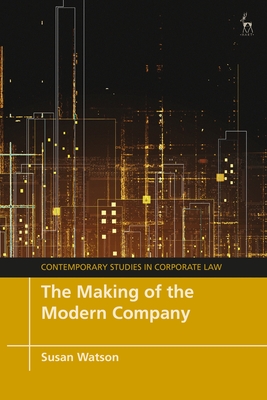图书简介
This book adopts a historical perspective to highlight, and bring back into focus, the key features of the modern company. A central argument in the book is that legal personhood attaching to an entity containing a corporate fund seeded by shareholders is a direct and inevitable consequence of limited liability and the company’s status as a separate legal entity from its shareholders. Management by a board subject to legal duties to the company as an entity that can exist in perpetuity facilitates a long term perspective by the board that can accommodate both shareholder and stakeholder interests. These defining characteristics differentiate the modern company from other business forms. The Making of the Modern Company applies a 21st-century lens to the corporation through its history to identify turning points in its development. It sets out how key features emerged in the course of two separate developmental cycles in English corporate law: first with the English East India Company in the 17th century, and then with general incorporation statutes in the 2nd half of the 19th century. The book’s historical perspective highlights that the key features are part of the ’secret sauce’ of modern companies. Each cycle coincided with unparalleled periods of economic success associated with corporate activity This book will be of interest to corporate law and governance academics, theorists and practitioners, those who study the company from related disciplines, and anyone who questions why uncertainty still exists about the structure of a legal form that has been described as ’amongst mankind’s greatest inventions’.
1. Introduction I. Introduction II. Key Features III. Property versus Social Entity IV. The Agency Problem V. The Making of the Modern Company PART ONE DEVELOPMENT OF THE MODERN COMPANY 2. Persona Ficta and Joint Stock I. Two Kinds of Legal Organisation II. Early Corporate Enterprises III. Early Funds IV. Contractual Joint Stock Companies V. Business Corporations VI. Separate Legal Entity VII. Persona Ficta VIII. Conclusion 3. The Transition to Permanent Capital in the English East India Company I. Introduction II. The First Twenty Years III. The Second Twenty Years IV. The Third Twenty Years V. The 1657 Charter 4. Corporate Governance in the English East India Company I. Introduction II. Development of Governance Structures in Early Business Corporations III. Shareholder Activism in the English East India Company IV. Maurice Thomson and the Emergence of Directors’ Duties 5. The Rise and Fall of the English East India Company I. The English East India Company with Permanent Capital II. The Impact of the Legal Structure III. Private Trade in the English East India Company IV. The Fall of the English East India Company V. Conclusion - The English East India Company in Context 6. The Early Emergence of Directors’ Duties I. Introduction II. Emerging Obligations of the Governing Body of the English East India Company III. Role of the Oath in the Obligations of Governing Bodies IV. Charitable Corporation v Sutton V. Development of Duties Around Conflict of Interest 7. Liability of Shareholders of Business Corporations I. Introduction II. Liability of Shareholders to Third-Party Creditors III. Could Shareholders be Compelled to Contribute Capital to the Company? IV. Shift in Focus to the Contractual Joint Stock Company 8. The Significance of the Deed of Settlement Company I. Introduction II. The Bubble Act III. The Deed of Settlement Company IV. The Efficacy of the Deed of Settlement Company V. The Business Corporation in the Eighteenth Century VI. The Relative Adoption of the Two Corporate Forms VII. Corporate Governance in Deed of Settlement Companies VIII. Conclusion 9. General Incorporation Statutes I. Introduction II. The Joint Stock Companies Act 1844 III. The Joint Stock Companies Act 1856 IV. Limited Liability V. Was the Modern Company a Partnership or a Corporation? VI. Salomon v Salomon
Trade Policy 买家须知
- 关于产品:
- ● 正版保障:本网站隶属于中国国际图书贸易集团公司,确保所有图书都是100%正版。
- ● 环保纸张:进口图书大多使用的都是环保轻型张,颜色偏黄,重量比较轻。
- ● 毛边版:即书翻页的地方,故意做成了参差不齐的样子,一般为精装版,更具收藏价值。
关于退换货:- 由于预订产品的特殊性,采购订单正式发订后,买方不得无故取消全部或部分产品的订购。
- 由于进口图书的特殊性,发生以下情况的,请直接拒收货物,由快递返回:
- ● 外包装破损/发错货/少发货/图书外观破损/图书配件不全(例如:光盘等)
并请在工作日通过电话400-008-1110联系我们。
- 签收后,如发生以下情况,请在签收后的5个工作日内联系客服办理退换货:
- ● 缺页/错页/错印/脱线
关于发货时间:- 一般情况下:
- ●【现货】 下单后48小时内由北京(库房)发出快递。
- ●【预订】【预售】下单后国外发货,到货时间预计5-8周左右,店铺默认中通快递,如需顺丰快递邮费到付。
- ● 需要开具发票的客户,发货时间可能在上述基础上再延后1-2个工作日(紧急发票需求,请联系010-68433105/3213);
- ● 如遇其他特殊原因,对发货时间有影响的,我们会第一时间在网站公告,敬请留意。
关于到货时间:- 由于进口图书入境入库后,都是委托第三方快递发货,所以我们只能保证在规定时间内发出,但无法为您保证确切的到货时间。
- ● 主要城市一般2-4天
- ● 偏远地区一般4-7天
关于接听咨询电话的时间:- 010-68433105/3213正常接听咨询电话的时间为:周一至周五上午8:30~下午5:00,周六、日及法定节假日休息,将无法接听来电,敬请谅解。
- 其它时间您也可以通过邮件联系我们:customer@readgo.cn,工作日会优先处理。
关于快递:- ● 已付款订单:主要由中通、宅急送负责派送,订单进度查询请拨打010-68433105/3213。
本书暂无推荐
本书暂无推荐















